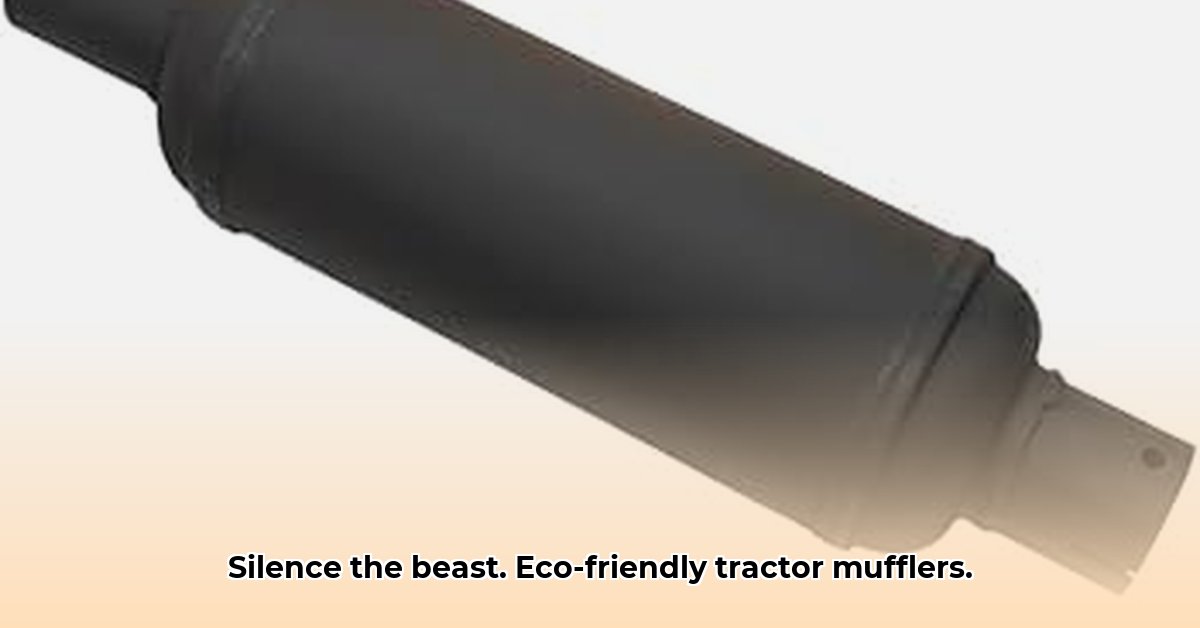
Choosing the right muffler for your small tractor isn't just about comfort; it's a crucial step towards sustainable agriculture. Excessive noise pollution from tractors negatively impacts wildlife, nearby communities, and even your own hearing health. Furthermore, harmful exhaust emissions contribute to poor air quality. This guide provides actionable steps to select and maintain a muffler that minimizes environmental impact while maximizing value.
Understanding the Noise and Emissions Challenge
Finding comprehensive data about small tractor muffler performance is surprisingly difficult. Manufacturers often lack detailed specifications regarding noise reduction (measured in decibels, or dB) and emission levels. This lack of transparency makes informed comparisons challenging, hindering sustainable choices. For example, it's difficult to assess whether a muffler boasting a "low-noise" claim truly offers significant noise reduction compared to alternatives.
Dr. Emily Carter, Environmental Engineering Professor at Purdue University, emphasizes, "The absence of standardized testing and transparent data on muffler performance is a critical obstacle to sustainable agriculture. Farmers deserve clear information to make informed, environmentally responsible choices."
The environmental implications are significant. High decibel levels contribute to noise pollution, potentially harming wildlife and human hearing. Exhaust emissions contain pollutants detrimental to both human and animal health, impacting air quality and overall ecosystem health.
Choosing a Sustainable Small Tractor Muffler: A Checklist
Selecting a sustainable muffler involves considering several key factors beyond just the initial cost. The following checklist provides a framework for informed decision-making:
1. Noise Reduction (dB): Lower decibel ratings indicate quieter operation. However, marketing claims alone are insufficient. Look for independent test results or manufacturer data sheets specifying dB reduction levels. A 10dB reduction translates to a perceived halving of the noise level.
2. Material Composition: Durable and corrosion-resistant materials like stainless steel extend the muffler's lifespan, reducing the need for frequent replacements and minimizing waste. While other materials might be initially cheaper, their shorter lifespan might lead to higher long-term costs and increased environmental impact.
3. Durability and Longevity: A longer-lasting muffler translates to reduced waste and lower lifecycle costs. Invest in robust construction and high-quality materials for extended service life. Consider warranties as an indicator of manufacturer confidence in product durability.
4. Price and Value: Don't solely focus on the upfront cost. Evaluate the muffler's lifespan, performance, and maintenance requirements. A more expensive, high-quality muffler might be more cost-effective in the long run due to its durability.
5. Compatibility: Ensure the muffler is compatible with your specific tractor model. Consult your owner's manual or contact your tractor's manufacturer before purchasing. Incorrect fitment can lead to performance issues or even safety hazards.
6. Lifecycle Considerations: Assess the entire lifecycle, from manufacturing to disposal. Consider mufflers made from recyclable materials and inquire about the manufacturer's commitment to sustainable production practices.
Maintaining Your Muffler for Extended Lifespan
Proper maintenance significantly extends muffler lifespan and minimizes environmental impact.
1. Regular Inspections: Regularly inspect for damage, rust, loose parts, or blockages. Early detection of problems enables timely repairs, preventing major issues.
2. Cleaning: Keep the muffler free from dust, debris, and buildup. Use compressed air or a suitable brush for cleaning. Accumulated debris can impact performance and increase noise.
3. Promptly Address Issues: Immediately address any damage or performance issues. Small repairs prevent larger, more expensive problems and promote longer muffler life.
Advocating for Change: The Need for Transparency
The lack of readily available data on muffler performance is a significant challenge. We need manufacturers to provide comprehensive, transparent information on noise reduction and emission levels. It’s vital to advocate for:
- Standardized Testing: Support efforts to establish standardized testing protocols for agricultural equipment, ensuring consistent and comparable performance data.
- Manufacturer Transparency: Contact manufacturers directly, urging them to provide detailed specifications and independent test results.
- Regulation: Support stricter emission and noise regulations for agricultural machinery.
Resources and Further Information
While manufacturer specifications are paramount, seeking information from additional sources can be beneficial.
- Agricultural Extension Services: Contact your local agricultural extension office for advice and resources.
- Online Forums and Communities: Engage with online communities of farmers and agricultural professionals to share experiences and information.
- Regulatory Bodies: Check the websites of relevant regulatory bodies for noise and emission standards.
Conclusion: Sustainable Farming Starts with Small Decisions
Choosing a sustainable small tractor muffler is a seemingly small but impactful step toward environmentally responsible farming practices. By making informed decisions based on this guide and advocating for greater transparency from manufacturers, you contribute to a quieter, cleaner, and more sustainable agricultural future. Remember that consistent maintenance is key to maximizing the lifespan and environmental benefits of your chosen muffler.